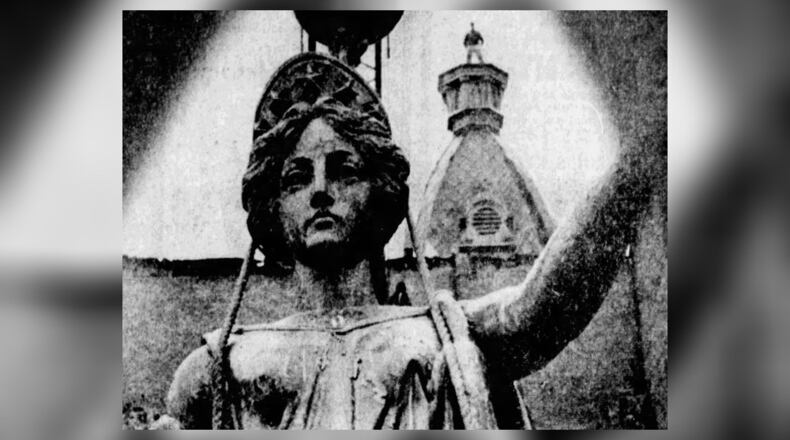Gebhart, who made his wealth in the galvanized sheet metal business, decided that instead of hiring a famous artist to create the statue, he’d give the job to his company’s workers.
The result was not a tribute to commerce, but instead represented the Goddess of Liberty. It was made of malleable zinc, stood 11 feet high and weighed 500 pounds.
The statue was placed atop the opera house on July 3, 1879, in conjunction with the city’s Fourth of July celebrations.
The goddess stood resting her right hand upon the sword of justice, and in her left she extended the laurel wreath of victory.
Legend has it that Gephart originally conceived of the statue as the Greek goddess of music, but instead of a flute, he gave her a sword, perhaps to guard his opera house. One issue might have been that there is no singular deity known as the goddess of music, with the closest being a trio known as the Greek Goddesses of Music, Poetry and the Arts.
According to a 1969 Dayton Daily News article, Martin J. Kelley, chairman of the Montgomery County Historical Society, said at the time it was “the first to be placed on a public building in Dayton.”
Sometime during the 1880s, the goddess lost her laurel wreath, thus puzzling many citizens as to her then awkward looking stance. How it became lost is unknown.
The statue stayed atop the opera house for more than 90 years before being moved. The opera house was renamed four times over the years, ending up as Mayfair Theatre. And the statue became known as the Mayfair Lady.
Mayfair Lady was removed from the building by wrecking contractor S.G. Lowendick & Sons on Wednesday, Jan. 29, 1969. Despite two fires and almost a century of the Ohio elements, she was said to still look remarkably good. The only marks of time were her left hand, some say the result of wind, turned to an awkward position and some flakey zinc spots.
Dayton’s mayor at that time, Dave Hall, acquired the statue. He thought about putting it in his residence, but decided to donate it to the Dayton Art Institute instead.
The statue stood outside the Dayton Art Institute until 2001, when it was put in storage. Time and weather had taken a toll and the Lady had lost all of one arm and part of the other.
In 2011, the statue was moved to Carillon Historical Park where it still resides, overlooking the Dayton Carousel of Innovation in the park’s Heritage Center.
In a 2011 Dayton Daily News article, Brady Kress, president and chief executive of Dayton History, the nonprofit organization that operates Carillon Park, said the statue was “part of the late 19th- and 20th-century downtown landscape.” And, “from an artifact standpoint, she is one of those silent witnesses of a tremendous amount of growth in the Miami Valley and in Dayton.”
Credit: JIM NOELKER
Credit: JIM NOELKER
About the Author





